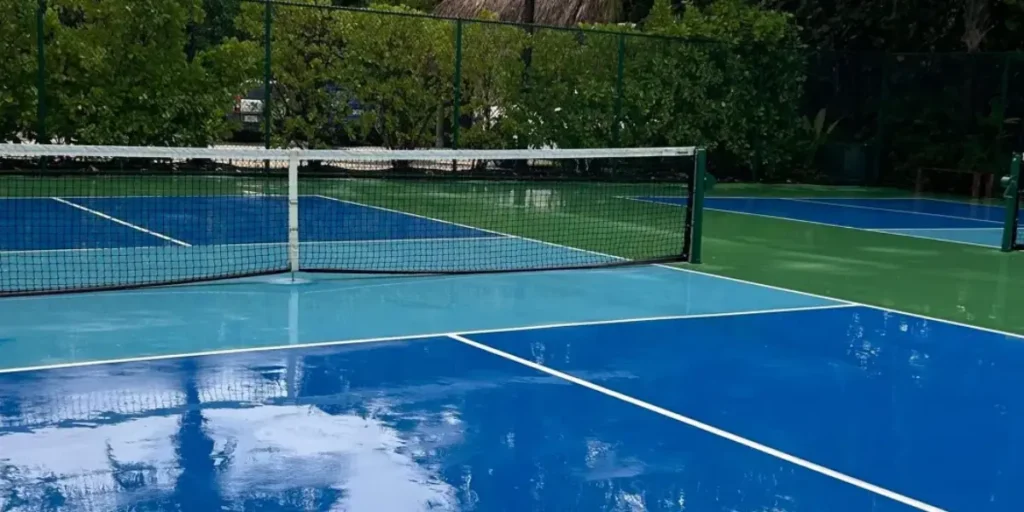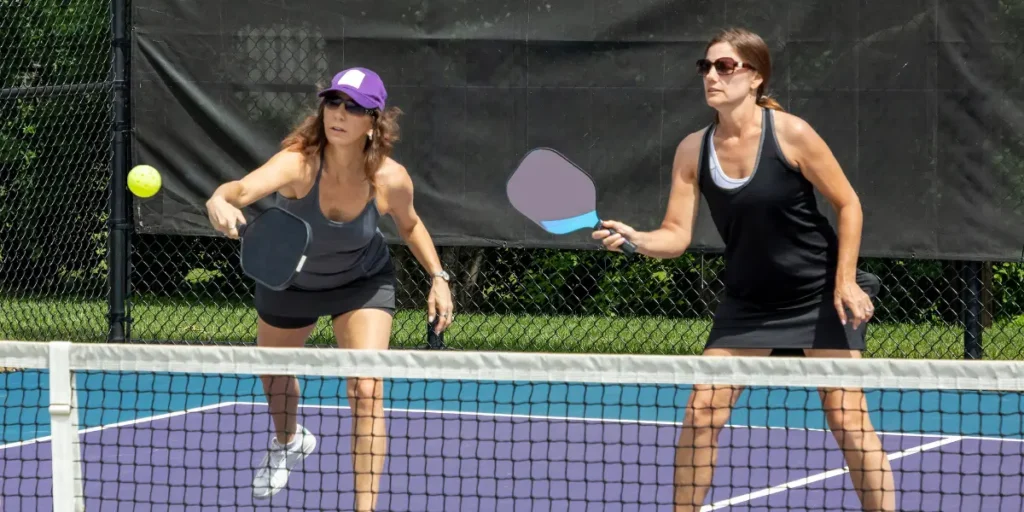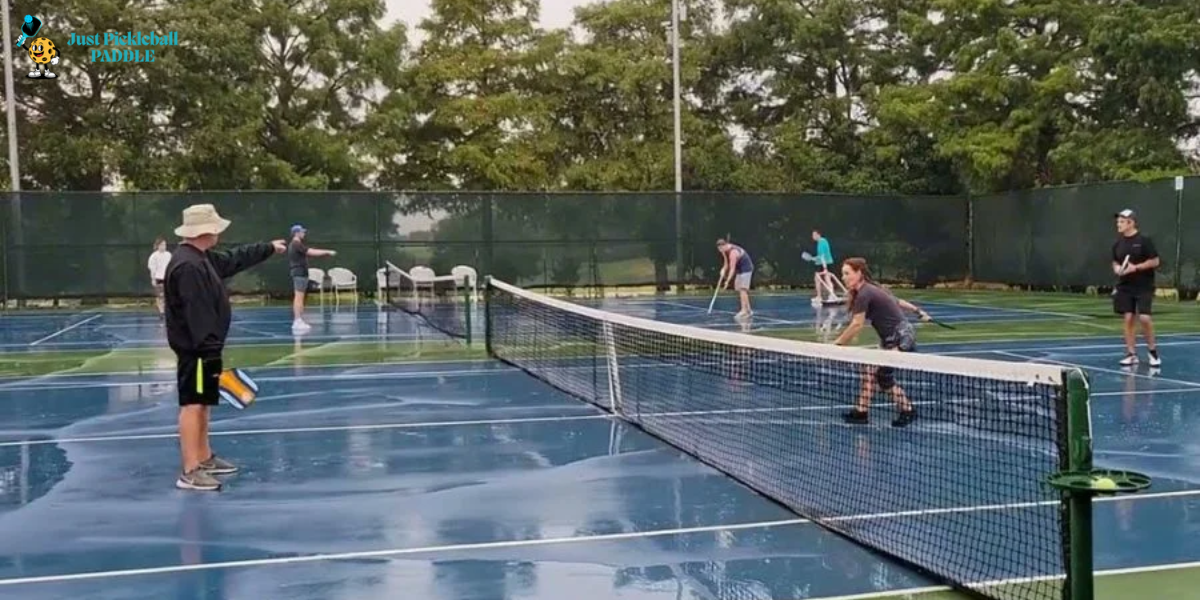Have you ever found yourself caught in the rain while playing pickleball and wondered if it’s still safe to continue? Rain can disrupt outdoor pickleball plans, leaving players debating whether to brave the wet conditions or wait it out.
If you hate missing a game, you might feel tempted to play through the drizzle. But is it worth the risk?
In this article, I’ll guide you through navigating rainy pickleball days safely, offering tips to adapt your gameplay, manage the risks, and know when it’s best to step off the court.
Can You Play Pickleball in the Rain or on Wet Courts?
Playing pickleball on a wet court is generally not recommended due to safety concerns. Wet courts, often coated with an acrylic finish, become extremely slippery, increasing the risk of slips and injuries like sprains or fractures.
Imagine this: you’re mid-game, running for a shot, and your foot suddenly slides on a damp patch. Not only could you lose the point, but you might also find yourself sidelined with an injury. These risks make it crucial to understand the impact of wet conditions.
However, wet courts can offer an opportunity to improve your balance and footwork through controlled movements. Practicing on slightly damp surfaces, while being cautious, can help you develop steadiness and precision. That said, fully wet courts are best avoided to ensure your safety and enjoyment.
Is Pickleball Safe to Play During Light Rain or Drizzle?
Playing pickleball in light rain or drizzle can be relatively safe if the court isn’t overly slippery, but caution is essential. Wet surfaces reduce traction, increasing the risk of minor injuries like slips or sprains.
Additionally, moisture on the ball and paddle can affect gameplay by making shots less predictable. Always assess the conditions, and if you notice traction issues or water buildup, it’s safer to stop playing and wait for improved weather.

But if you decide to play pickleball in the rain or on a wet court you need to know some tips before playing
Tips for Playing Pickleball in Rain or on Wet Conditions
Playing pickleball in wet conditions, whether on a damp court or during light rain, requires adjustments to ensure safety and enjoyment.
Start by inspecting the court for puddles or slick areas. Use tools like squeegees or towels to remove excess water, and test the surface with light movements to ensure it’s not dangerously slippery.
Gear is crucial when navigating wet conditions. Wear shoes with non-slip soles designed for outdoor sports to improve traction and stability. Enhance your paddle grip with specialized tape to maintain control, and keep a towel handy to dry the paddle and ball regularly. Wearing water-resistant clothing and a cap or visor helps keep you comfortable and focused.
To adapt to wet conditions, focus on steady, controlled movements. Slow down your pace, avoid abrupt changes in direction, and use soft, precise shots to maintain accuracy. Position yourself strategically to minimize unnecessary movement and reduce the risk of slipping.
Strategically, shift from aggressive power plays to more precise shots, such as drop shots and soft returns, which are easier to control on wet courts. Position yourself closer to the center of the court to minimize movement and stay balanced.
Finally, monitor the court throughout your game. Continuously monitor the court for changing conditions. Adjust your movements and gameplay as needed to stay safe while enjoying the game.
By taking these precautions and adapting your approach, you can enjoy playing pickleball while minimizing the risks associated with wet conditions.
How Wet Conditions Affect Pickleball Equipment

Wet conditions can significantly impact your pickleball equipment, often reducing performance and longevity. When exposed to moisture, the ball absorbs water, becoming heavier and less bouncy, which makes its flight unpredictable and affects shot precision.
Similarly, a wet paddle can lose its grip, making it harder to control and increasing the risk of mishits. Prolonged exposure to rain may also damage paddles with wooden cores or less durable materials, potentially leading to warping or peeling.
To prevent damage, take proactive measures before, during, and after playing in wet conditions. Use paddles made from water-resistant materials and apply grip-enhancing tape to improve handling.
Keep extra towels handy to regularly dry both the paddle and the ball during play. If the ball becomes too waterlogged, replace it with a dry one to maintain better control and consistency in your game.
After playing, store your equipment properly. Wipe down your paddle and ball thoroughly with a dry towel to remove moisture. Allow your paddle to air-dry completely before placing it in a protective cover or bag. Avoid leaving equipment in damp or enclosed spaces, as trapped moisture can lead to mold, warping, or other damage.
By taking these steps, you can mitigate the effects of wet conditions and ensure your equipment remains in top shape for future games.
When to Stop Playing Pickleball in the Rain or on Wet Courts

Knowing when to stop is essential for staying safe. If the court becomes excessively slick or standing water affects traction, pause the game immediately. Likewise, if the ball’s bounce becomes unpredictable or your paddle grip starts slipping, it’s better to step away than risk injury.
Heavy rain or worsening conditions, such as reduced visibility, are also clear signals to stop. Playing in these situations not only increases the chance of accidents but also takes away the enjoyment of the game. Always prioritize your safety and that of your fellow players.
While stopping mid-game might feel frustrating, it ensures you can return to play with full confidence once conditions improve. Rainy days can even help you grow as a player by encouraging adaptability and control. When the court is dry again, you’ll be ready to bring your best game.
FAQs
Ensure the court isn’t too slippery – test traction with a few light movements
Play at a slower pace to reduce the risk of falls
No running, sliding, or cutting – think walking or standing only!
Outdoor pickleballs, such as Dura Fast 40 or Franklin X-40, are more durable and can handle damp conditions better than indoor balls. However, they should still be replaced if they become waterlogged.
The time it takes for a pickleball court to dry depends on factors like weather conditions, surface material, and drainage. On a sunny day with good ventilation, it may take 30 minutes to an hour. However, in humid or cloudy weather, it can take significantly longer. Using tools like squeegees can speed up the process.
To dry a wet pickleball court, use a squeegee or court roller to remove standing water. Towels can help with smaller puddles, and a leaf blower can accelerate drying. Allow the court to air-dry fully to ensure safe play, especially in humid conditions.
To avoid injuries, wear non-slip shoes for better traction and adjust your movements to a slower, more controlled pace. Monitor the court for slick spots or puddles and avoid sudden directional changes. Always test the surface before playing and stop immediately if conditions worsen.
Related Post
Conclusion
Playing pickleball in the rain might seem daunting, but with the right precautions, it can turn into a fun and rewarding experience. I’ve had my fair share of slippery courts and unexpected drizzles, and adapting your game is all part of the adventure.
Just remember to prioritize safety—no game is worth an injury. So next time the skies look a bit gray, don’t rush to cancel your plans.
Stay safe, and most importantly, enjoy the game. I’d love to hear your own rainy-day pickleball stories—feel free to share them in the comments below!

